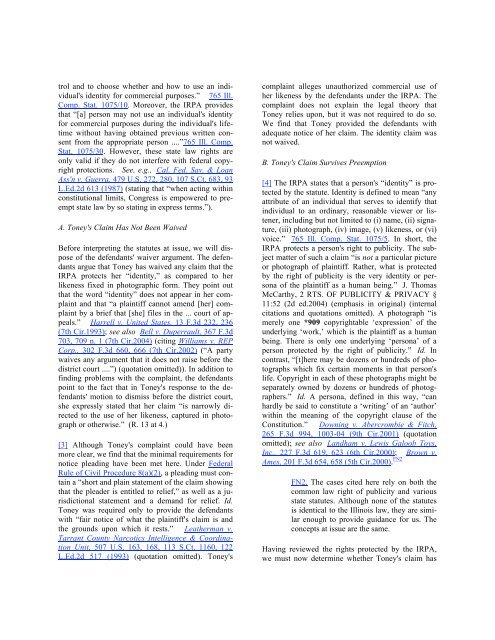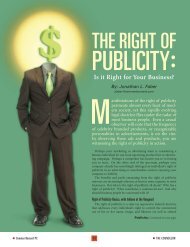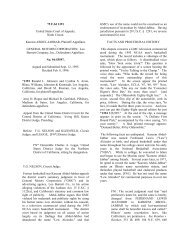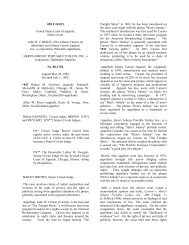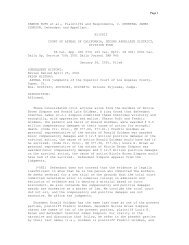Toney v. L'Oreal - Right Of Publicity
Toney v. L'Oreal - Right Of Publicity
Toney v. L'Oreal - Right Of Publicity
Create successful ePaper yourself
Turn your PDF publications into a flip-book with our unique Google optimized e-Paper software.
trol and to choose whether and how to use an individual's<br />
identity for commercial purposes.” 765 Ill.<br />
Comp. Stat. 1075/10. Moreover, the IRPA provides<br />
that “[a] person may not use an individual's identity<br />
for commercial purposes during the individual's lifetime<br />
without having obtained previous written consent<br />
from the appropriate person ....”765 Ill. Comp.<br />
Stat. 1075/30. However, these state law rights are<br />
only valid if they do not interfere with federal copyright<br />
protections. See, e.g., Cal. Fed. Sav. & Loan<br />
Ass'n v. Guerra, 479 U.S. 272, 280, 107 S.Ct. 683, 93<br />
L.Ed.2d 613 (1987) (stating that “when acting within<br />
constitutional limits, Congress is empowered to preempt<br />
state law by so stating in express terms.”).<br />
A. <strong>Toney</strong>'s Claim Has Not Been Waived<br />
Before interpreting the statutes at issue, we will dispose<br />
of the defendants' waiver argument. The defendants<br />
argue that <strong>Toney</strong> has waived any claim that the<br />
IRPA protects her “identity,” as compared to her<br />
likeness fixed in photographic form. They point out<br />
that the word “identity” does not appear in her complaint<br />
and that “a plaintiff cannot amend [her] complaint<br />
by a brief that [she] files in the ... court of appeals.”<br />
Harrell v. United States, 13 F.3d 232, 236<br />
(7th Cir.1993); see also Bell v. Duperrault, 367 F.3d<br />
703, 709 n. 1 (7th Cir.2004) (citing Williams v. REP<br />
Corp., 302 F.3d 660, 666 (7th Cir.2002) (“A party<br />
waives any argument that it does not raise before the<br />
district court ....”) (quotation omitted)). In addition to<br />
finding problems with the complaint, the defendants<br />
point to the fact that in <strong>Toney</strong>'s response to the defendants'<br />
motion to dismiss before the district court,<br />
she expressly stated that her claim “is narrowly directed<br />
to the use of her likeness, captured in photograph<br />
or otherwise.” (R. 13 at 4.)<br />
[3] Although <strong>Toney</strong>'s complaint could have been<br />
more clear, we find that the minimal requirements for<br />
notice pleading have been met here. Under Federal<br />
Rule of Civil Procedure 8(a)(2), a pleading must contain<br />
a “short and plain statement of the claim showing<br />
that the pleader is entitled to relief,” as well as a jurisdictional<br />
statement and a demand for relief. Id.<br />
<strong>Toney</strong> was required only to provide the defendants<br />
with “fair notice of what the plaintiff's claim is and<br />
the grounds upon which it rests.” Leatherman v.<br />
Tarrant County Narcotics Intelligence & Coordination<br />
Unit, 507 U.S. 163, 168, 113 S.Ct. 1160, 122<br />
L.Ed.2d 517 (1993) (quotation omitted). <strong>Toney</strong>'s<br />
complaint alleges unauthorized commercial use of<br />
her likeness by the defendants under the IRPA. The<br />
complaint does not explain the legal theory that<br />
<strong>Toney</strong> relies upon, but it was not required to do so.<br />
We find that <strong>Toney</strong> provided the defendants with<br />
adequate notice of her claim. The identity claim was<br />
not waived.<br />
B. <strong>Toney</strong>'s Claim Survives Preemption<br />
[4] The IRPA states that a person's “identity” is protected<br />
by the statute. Identity is defined to mean “any<br />
attribute of an individual that serves to identify that<br />
individual to an ordinary, reasonable viewer or listener,<br />
including but not limited to (i) name, (ii) signature,<br />
(iii) photograph, (iv) image, (v) likeness, or (vi)<br />
voice.” 765 Ill. Comp. Stat. 1075/5. In short, the<br />
IRPA protects a person's right to publicity. The subject<br />
matter of such a claim “is not a particular picture<br />
or photograph of plaintiff. Rather, what is protected<br />
by the right of publicity is the very identity or persona<br />
of the plaintiff as a human being.” J. Thomas<br />
McCarthy, 2 RTS. OF PUBLICITY & PRIVACY §<br />
11:52 (2d ed.2004) (emphasis in original) (internal<br />
citations and quotations omitted). A photograph “is<br />
merely one *909 copyrightable ‘expression’ of the<br />
underlying ‘work,’ which is the plaintiff as a human<br />
being. There is only one underlying ‘persona’ of a<br />
person protected by the right of publicity.” Id. In<br />
contrast, “[t]here may be dozens or hundreds of photographs<br />
which fix certain moments in that person's<br />
life. Copyright in each of these photographs might be<br />
separately owned by dozens or hundreds of photographers.”<br />
Id. A persona, defined in this way, “can<br />
hardly be said to constitute a ‘writing’ of an ‘author’<br />
within the meaning of the copyright clause of the<br />
Constitution.” Downing v. Abercrombie & Fitch,<br />
265 F.3d 994, 1003-04 (9th Cir.2001) (quotation<br />
omitted); see also Landham v. Lewis Galoob Toys,<br />
Inc., 227 F.3d 619, 623 (6th Cir.2000); Brown v.<br />
Ames, 201 F.3d 654, 658 (5th Cir.2000). FN2<br />
FN2. The cases cited here rely on both the<br />
common law right of publicity and various<br />
state statutes. Although none of the statutes<br />
is identical to the Illinois law, they are similar<br />
enough to provide guidance for us. The<br />
concepts at issue are the same.<br />
Having reviewed the rights protected by the IRPA,<br />
we must now determine whether <strong>Toney</strong>'s claim has


